01-01: Introduction to ligno-cellulosic biomass
Wood has been the first source of energy for humankind, used in a variety of applications such as heating, cooking, providing industrial heat (i.e. for melting metals or producing clay bricks), etc. In the last century it was replaced by fossil fuels such as coal, oil, and natural gas, mainly because of their higher energy density which allows more comfortable or efficient use. In spite of this, CIFOR estimates that about two billions cubic meters of wood and charcoal (produced from wood) are still consumed every year in the world (Figure 01-01 1). According to the International Energy Agency, about 2.5 billion people in developing countries depend today on this source of energy just for cooking requirements.
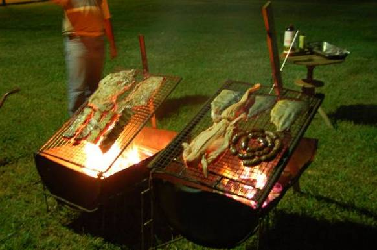
|
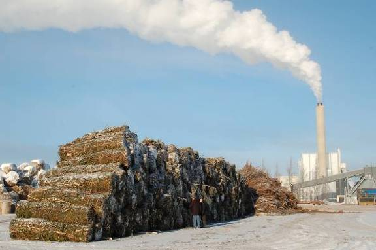
|
| Figure 01-01 1: Use of ligno-cellulosic biomass for traditional cooking in Argentina (a) and modern large CHP district heating in Finland (source: Picchi) | |
Nowadays also in industrialized countries there is a clear reappraisal of wood as a source of energy. It should be noted that energy use in those countries was never completely abandoned, but mostly limited to aesthetic or traditional uses, often in combination with fossil fuels. The new development of the bioenergy sector relies on modern technologies for fuel treatment and energy conversion, highly mechanized, automatic, efficient and with low polluting emissions. Thanks to these solutions, wood is again a competitive alternative to other fuels, even without considering the environmental aspects and declining availability of fossil fuels.
The present chapter introduces the key aspects of wood material as a fuel, and its interaction with the main energy conversion technologies.
01-01-01: Types of woody fuels and combustion devices
Logs
Traditionally wood for energy production is consumed in form of logs of different size according to the used appliance (oven, stove, fireplace, etc.). This fuel is still popular, also because its production requires very simple equipment and is often self-produced in rural areas (Figure 01-01 2).

|
| Figure 01-01 2: Wood fuel industrial splitter, note the loose/splitted material and the packaging ready for delivery (right). (source: Picchi) |
In all cases logs are manually fed in to the combustion device. Generally, the energy efficiency is between 20 and 50 %. At present, modern wood fuel (logs) stoves are still manually fed, but perform much better in terms of efficiency (up to 80%). It is due to the introduction/improvements of combustion technologies (such as reverse flame combustion), which separates phases of drying, pyrolysis and combustion, optimizing each of them. Such boilers have usually a limited size due to the manual feeding system and in consequence are capable of providing heat to a single household/farm (Figure 01-01 3).
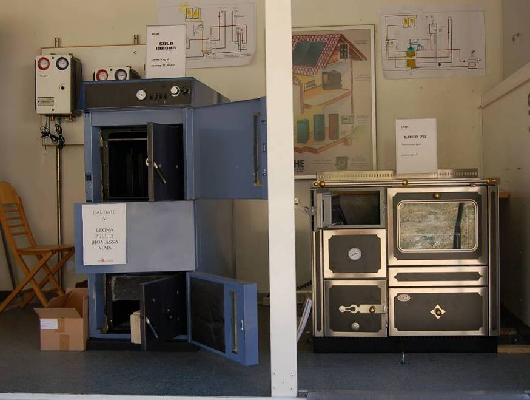
|
| Figure 01-01 3: Two types of wood fuel appliances, a reverse flame boiler (left) and a traditional wood kitchen (right). Note that the size of the loading chamber will influence the size of the wood fuel logs to be used. (source: Picchi) |
Wood chips
Wood chips are the product of chipping. This operation is performed by means of specific cutting devices which comminute whole trees, branches, logs, bundles and any sort of woody raw material (Figure 01-01 4). The sizes of wood chips vary according to the final user requirements and the machinery used, but is generally smaller than 5 cm.

|
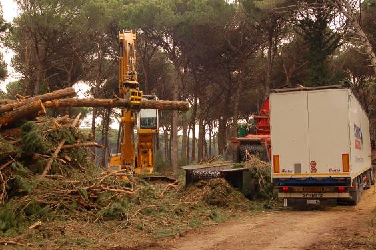
|
| Figure 01-01 4: Chippers fed with small sized trees and branches from river bank maintenance (left) and whole pine trees of large size (right) will produce a unique fuel type: wood chips. (source: Picchi) | |
One of the main advantages of wood chips is its liquid-like behaviour, being able to adapt to the shape of the different containers (truck-bin, deposits, silos, etc. as shown in Figure 01-01 5) and to be moved and automatically fed to the boiler with screw conveyers, pistons, and so on (Figure 01-01 6).

|
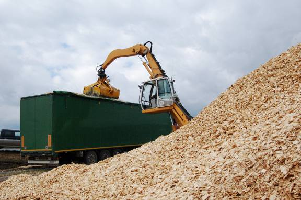
|
| Figure 01-01 5: Behaving as a quasi-fluid wood chips can adapt to different shapes, optimizing transport and storage (source: Picchi) | |
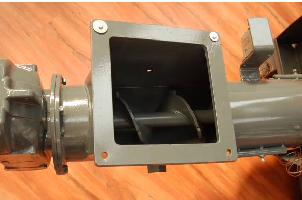
|

|
| Figure 01-01 6: Examples of screw conveyers for wood chips boilers. This feeding system is very sensitive to chips size, and an irregular fuel with oversized material could jam the screw (source: Picchi) | |
Due to these properties, wood chips boilers have an automatic fuel feeding control, which enables for a very efficient combustion. Those systems are also very flexible in size, and may range from a few kW to several MW (Figure 01-01 7).
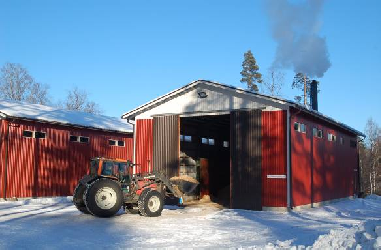
|
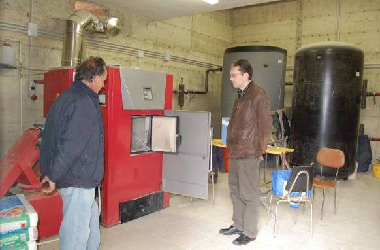
|
| Figure 01-01 7: Two examples of wood chips appliances: a small district heating in Finland (left, note the wood chips deposit and the front loader moving the fuel) and a domestic boiler for heating a rural tourism complex in Italy (right) (source: Picchi) | |
Hog fuel
Hog fuel is basically similar to wood chips (Figure 01-01 8), but of bigger size and irregular shape and surface. The sharp knives of wood chippers are very delicate if used for comminuting woody biomass contaminated with sand, soil or stones. In case of dirty raw material, such as tree stumps or ligno-cellulosic wastes (such as used pallets with iron nails) a crusher is usually used (Figure 01-01 9).This type of machine operates by violently breaking the wood instead of cutting it.
Hog fuel is less adaptable to automatic feeding with screw conveyers, which diameter must be higher. Alternative feeding systems such as pistons and pushers are more reliable with such irregular fuel.
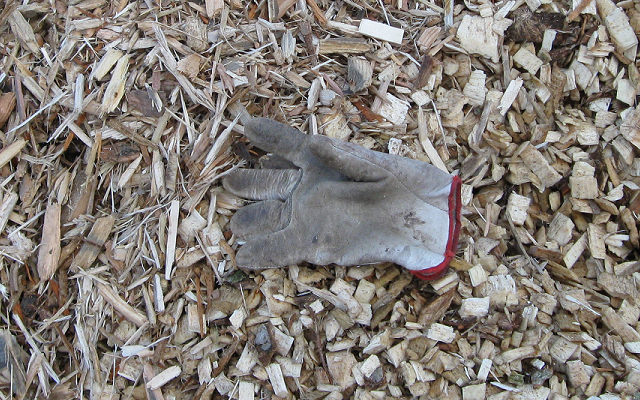
|
|
| Figure 01-01 8: Comparison of hog fuel (left) and chips (right)
(source: Picchi) The glove is to give an indication of particle sizes |
|
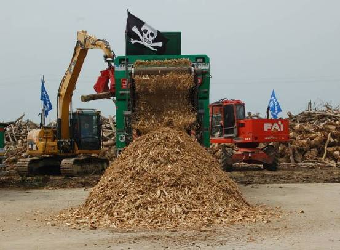
|
|
| Figure 01-01 9: Wood crusher at work (source: Picchi) | |
All the wood fuels above mentioned are just the result of a physical reduction in size of the original tree (tree parts) and/or wooden wastes used as raw material for fuel production. Nowadays some new forms of pre-processed bio fuels are becoming more popular:
Pellets
Pellets are small cylinders of 6 mm to 25 mm in diameter and 3 mm to 50 mm in length produced from different raw materials very often including ligno-cellulosic biomasses (Figure 01-01 10). Some most important advantages of using pellets as bio-fuels are:
• reduce costs of transportation, handling, and storage
• reduce plant investment and further maintenance costs by using homogenous fuel for combustion
• homogenize the wide variety of available biomasses and to produce a fuel better matching the narrow specifications for modern boilers
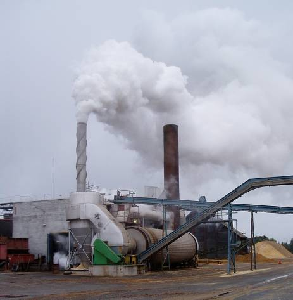
|
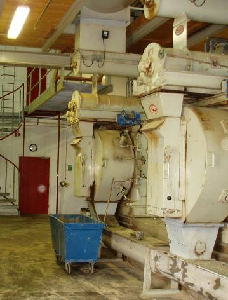
|
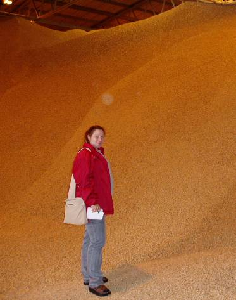
|
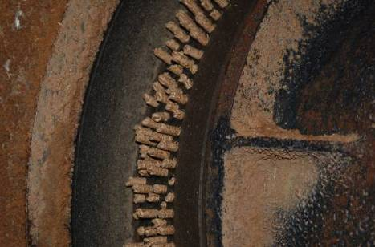
|
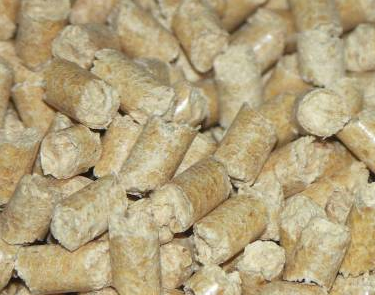
|
| Figure 01-01 10: Pellets produced from wood dusts; production plant (upper left), mill producing pellets (upper middle), stock of pellets (upper right), pellets extruder (lower left), close-up view of wooden pellets (lower right) (source: Zethræus and Picchi) | |
Important limitation of pellets it the fact that these must be protected from the weather. Pellets swell when are exposed to humid conditions and finally degrade to their original form (initial particle size and density). The pellets quality can be downgraded due to biological degradation by means of microorganisms, if not properly handled; pellets are typically stored in containers or covered storages to diminish an effect of weathering.
Briquette
Briquette (or briquet) is a block of compressed flammable matter used further as a fuel (Figure 01-01 11). The most apparent difference between briquettes and pellets is a size; briquettes are generally bigger then pellets (from 20 mm to 100 mm in diameter).
Briquettes are more brittle compared to pellets and are less resistant for mechanical wear. The bulk density of briquettes is ~500 kg/m3, what is significantly higher that the bulk density for the saw dust and cutter shavings (usually utilized for manufacturing of briquettes).
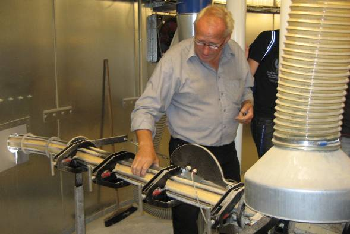
|

|
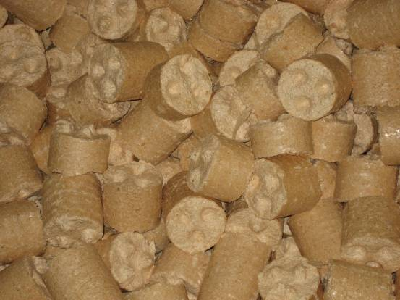
|
|
| Figure 01-01 11: Briquettes produced from wood dusts; production plant (upper left), stock of briquettes (upper right) close-up view of wooden briquettes (lower) (source: Zethræus) | |
Burning wood briquettes (and pellets) is far more efficient than burning firewood. The combustion equipment for briquettes must be flexible enough to handle saw dust and shavings since the briquettes will most probably break before they actually enter into the combustion chamber. Therefore, briquettes are not suitable for small-size burners (such as single-family houses), fitting better in to large scale applications.
Torrefied wood
Torrefaction is currently being considered as a biomass feedstock pre-treatment particularly suitable for further thermal conversion. Torrefaction increases the calorific value of the biomass. Depending on the applied process conditions, torrefied biomass is brown to dark-brown and sometimes might approach the properties of coal (Figure 01-01 12).
After torrefaction the biomass is relatively dry (1 to 6 % moisture content on the dry weight basis) and the hygroscopic nature of biomass is significantly reduced. Torrefied wood, in contrast to non treated wood, is not hydrophilic and is highly preserved against biological degradation. Due to high content of lignin and unsaturated fatty acids in torrefied biomass, high density pellets with a bulk density of 750 to 850 kg/m3 can be produced. In consequence torrefied biomass is very attractive fuel for further combustion and/or gasification.
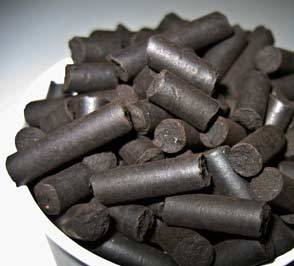
|
|
| Figure 01-01 12: Pellets from torrefied wood (source: http://www.goforwood.info) | |
An illustration of the different fuels originated from wood is presented in Figure 01-01 13. Some additional descriptions, technical details and process characteristics of mentioned fuels is also presented in other chapters of this handbook, and especially in 04-01-02f.
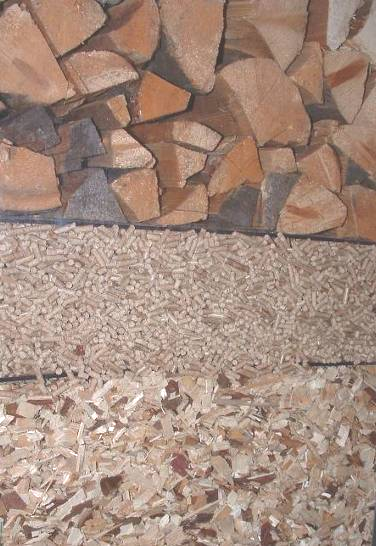
|
Figure 01-01 13: Direct visual comparison of the three main fuels from woody biomass: woodfuel (top), pellets (centre) and wood chips (bottom). (source: Picchi) | |
Table 01-01 1 summarizes the most important characteristics of market-available ligno-cellulosic biomasses. There is ongoing work to set federal standards for biomass qualities and properties, but for the moment interested readers are referred to download the "standards guide" assembled in the FOREST project.
| Biomass type |
size (mm) |
Moisture (%) |
Ash (%) |
Bulk density (kg/m3) |
Other important characteristics |
|
| Wood powder | < 1 |
10 - > 65 (M10 - M65+) |
0.5 - > 10 (A0.1 - A10+) |
100 - 350 (BD100 - BD350) |
||
| Saw dust | 1 - 5 | |||||
|
Wood chips |
Fine | 5 - 15 |
10 - > 55 (M10 - M55+) |
150 - 450 (BD150 - BD450) |
||
| Coarse | 15 - 50 | |||||
|
Small wood |
Chunk wood | 50 - 150 |
10 - > 55 (M10 - M55+) or, if expressed on dry basis: 11 - 122 (U11 - U122) |
• Energy density (kWh/kg or kWh/m3) • Proportion of split volume (%) • Decay • Cut-off surface |
||
| Firewood | 150 - 500 | |||||
| Whole wood | > 500 | |||||
| Pellets |
Diameter 6 - 25 Length 3 - 50 |
5 - 15 (M5 - M15) |
550 - 800 (BD550 - BD800) |
• Additives • Proportion of fines |
||
| Briquettes |
Diameter 20 - 100 Length 50 - 500 |
10 - 15 (M10 - M15) |
Part.density (g/cm3) 800 - 1 200 (DE0.8 - DE1.2) |
• Additives • Mechanical durability |
||
|
Hog fuel |
Fine | <3 |
10 - > 55 (M10 - M55+) |
150 - >450 (BD150 - BD450+) |
• Fine fraction 6 - 25 % of weight (F06 - F25) |
|
| Coarse | 3 - 350 | |||||
| Shavings |
10 - >30 (M10 - M30+) |
100 - >300 (BD100 - BD300+) |
||||
| Bark | 16 - 200 |
20 - >65 (M20 - M65+) |
1 - >10 (A1.0 - A10.0+) |
250 - 450 (BD250 - BD450) |
• Use shredding | |
| Table 01-01 1: Characteristics of different ligno-cellulosic biomasses | ||||||
The final concern is related to the scale of the power plant and combustion technology. The scale surely depends on the energy demand, but also on the available fuels characteristics.
The traditional and widespread firewood stoves, running with fuel wood (originated from logs) possesses several advantages:
• maturity of combustion technology
• uncomplicated design and simple manufacturing
• high security and reliability
• optimal fuel storage (reducing depreciation)
The most important limitation is difficulties in combustion process automation and requirement for the handy loading of the fuel. In consequence that technology is limited to small scale (single house), generation of heat only, and the power usually lower than 35 kW.
Conversely, the wood chips, pellets and briquettes, allows to reach much higher power for the single generator, and depends on the possible automation during handling and combustion. In that case the minimum plant power is in a range of 100 kW, but very often reaching 4 to 8 MW. In the industrial scale several bio-mass fuelled plats arrive to 100 MW or more. Moreover, the electricity cogeneration, beside the heat only is usually obtained.
01-01-02: Composition and properties of wood fuel
01-01-02a: The chemical constituents
From the chemical point of view, wood is a composite (mixture) of the following chemicals:
• Cellulose and hemicelluloses, as structural polymers, mainly constituted by carbon, hydrogen, and oxygen. Cellulose is a fibre, the main structural component of wood, and is the material used for paper production
• Lignin is a polymer giving plants their structural integrity. It is not easily degraded by microorganisms, thus its presence limits biological processes such as fermentation, while enhances combustion due to a high heating value. It should be mentioned that lignin serves as a natural binder keeping the integrity of pellets and briquettes. That is why wood is most suitable for the production of such products compared to herbaceous biomass (containing less lignin)
• Extractives are not structural components of biomass and include simple sugars, fats, waxes, gums, terpenes, pectines, resins, fatty acids etc. Their heating value is extremely high, and their higher content (together with lignin) in conifers explains why softwood has a higher heating value than hardwood
• Minerals are inorganic elements such as nitrogen, sulphur, chlorine and heavy metals bound to trees living tissues as nutrients. Their concentration is mostly limited to traces, but their presence can have large implications for the use of fuel (biomass) since they remain as ashes after combustion.
The quantity of main structural components varies between wood species but also between woods of different provenances. The approximate quantities detected in both soft- and hard-woods together with corresponding heating values are summarized in Table 01-01 2.
|
Cellulose (%) |
Hemi-cellulose (%) |
Lignin (%) |
Extractives (%) |
Minerals (%) |
Heating value (MJ/kg) |
|
|
Heating value for the component (MJ/kg) |
16 | 15 | 25 | 32 | 0 | |
| Hardwood | 43 - 50 | 20 - 25 | 16 - 25 | 2 - 8 | 0.2 - 0.8 | 18.5 - 19.5 |
| Softwood | 35 - 44 | 25 - 30 | 27 - 33 | 1 - 5 | 0.2 - 0.4 | 19 - 20.5 |
| Table 01-01 2: Chemical composition of soft- and hard- woods on the base of dry weight | ||||||
Apart from the minerals contained naturally in the wood, extraneous inorganic materials of various size fractions (such as dust, sand, stones, etc.) can be introduced in to biomass during its collection, handling, transportation and storage.
It is extremely important to assure proper management of the biomass along the whole supply chain in order to minimize its contamination with inorganic materials.
Minerals congregate themselves in to ashes and become solid residues remaining after thermal (thermo-chemical) conversion. Ashes reduce the combustion efficiency and represent a disposal problem. Therefore, it requires particular attention in the design of the boilers and management of the ash/minerals removal.
The chemical composition has also very strong influence on the storage properties of the material. Since the extractives are released from wood already at low temperatures (to some extent) and since cellulose and hemicellulose are both attacked by fungi during storage of the biomass, the fuel deteriorates and diminishes its energy content during improper storage. Some details describing these mechanisms and practices diminishing depreciation are presented in sections 03-00-02e and 03-01. More info regarding the chemical components of wood and these influences on the biomass quality and conversions can be also found in chapter 01-04.
01-01-02b: The physical properties of wood fuels
Focusing on practical approach to characterize ligno-cellulosic biomasses as a commodity following parameters should be considered:
1. Density; is the relationship between weight and actual volume of a given biomass. It has great influence in the storage and transport operations. The value of wood density depends on wood species and moisture content. It ranges between 150 to 1350 kg m-3 for exotic woods, where values of typical European species are ~400 kg m-3 for softwood species (such as spruce or pine), ~800 kg m-3 for hardwood species (oak) and up to 1200 kg m-3 in case of densified wooden pellets.
2. Bulk density; is the relationship between weight and apparent volume of a given biomass. It also takes account of the empty space included in the loose material. The bulk density depends on the nature of the woody biomass, their mutual agglomeration and the degree of compaction (Figure 01-01 14). Bulk density plays an even more important role during the phases of storage and transport, since it defines the actual characteristics of the handled biomass. It is often used as a trading parameter; biomass can be purchased either in terms of loose cubic meters or gross weight. The bulk density of woody biomass generally ranges from ~250 kg m-3 for wood chips to ~500 kg m-3 for broadleaves firewood and reaches the maximum value of about ~750 kg m-3 with wood pellets.
3. Water content; is an indicator of the quantity of water contained in the woody matter. It is a parameter strictly related to hygroscopic properties of wood tissues. Very low values of water content, around ~10% are typical of wood pellet, while for wood chips values are usually greater than 30 %. The moisture content can be even higher than 50% in case of industrial wooden chips procurement systems, since this is the typical value of recently felled trees (45-55 %). All the approximate values are related to the wet weight of biomass.
4. Energy content; also called Net Heating Value or Lower heating value (NHV, LHV), measured in
MJ kg-1 represents the energy contained in the chemical bonds, which may be available during the
combustion phase, (thus energy content does not include the energy required to evaporate the contained water).
NHV depends mainly on the water content, however the tree species should also be considered. The individual
proportion of structural chemical components (cellulose / lignin / hemicellulose ratio), as well as extractive
and ash contents may influence the overall NHV. For more details please refer to introductory chapter
04-00.

|
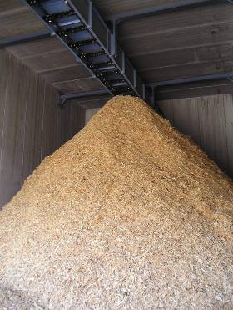
|

|
| Figure 01-01 14: Size and shape of the single wood particle plays a major role in the definition of bulk density. Loose chunks of wood (left) and wood chips (middle) will have a similar bulk volume, while pellets (right) due to their small and homogenous size will have a higher bulk density. (source: Casini) | ||
01-01-02c: The anatomical properties of woody biomasses
The chemical composition, structure and physical properties of woody biomass vary in different parts of the plant. It is due to fact that leaves, branches, trunks and roots have different functions. It is necessary therefore to be aware to distinguish such differences as they have important impact on further biomass quality, storage and use for energy. Schematically, above differences can be summarized as follows (Table 01-01 3):
| Tree part |
Cellulose (%) |
Hemi-cellulose (%) |
Lignin (%) |
Ash (%) |
Heating value qNET,DAF (MJ/kg) |
|
| Needles |
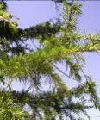
|
43 | 22 | 38 | 3 - 7 | 19 - 21 |
| Leafes |

|
30 - 50 | 20 - 30 | 15 - 35 | 1 - 8 | 18 - 19 |
| Branches |

|
37 | 34 | 35 | 3 - 8 | 18 - 20 |
| Trunk |

|
40 - 45 | 20 - 30 | 20 - 33 | 0.4 - 1 | 18 - 21 |
| Bark |
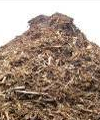
|
14 - 18 | 10 - 13 | 30 - 35 | 3 - 7 | 16 - 18 |
| Roots |

|
45 | 26 | 31 | >10 | 18 - 20 |
| Table 01-01 3: Chemical composition and net heating value of various tree parts (approximate values, estimated on the base of dry weight) | ||||||
Due to the above characteristics, it is important to consider that depending on the raw biomass to be used one can expect completely different fuel quality. E.g. by chipping trunks or whole trees, where the share of stem wood is very high, fuel with low ash content will be obtained. Nevertheless a difference can be already observed, if the whole tree is a conifer, needles will be included, increasing the final ash content.
Much lower ash content fuel will be produced from whole broadleaves trees in winter (when no leaves are present).
01-01-03: Introduction to fuels from trees of different origins
Forests are, in principle, the main source of raw material for the production of ligno-cellulosic biomass. However, forests are varying very much between each other, not only by the tree species composition but also on the topography, climate, accessibility, attitude and so on. Depending on the forest type the whole bio-energy system should be optimized; collection of biomass in mountains would be very different than from flatlands, and consequently also the fuel quality may vary.
For indicating the quantities it can be estimated that in 2010 the total supply of all woody resources in the EU 27 was ~1 billion m3. The forest provided 70% of this volume and the rest come from woody biomass originated differently (that forest). It provides an indicative potential for producing energy of 8500 PJ (Eurowood).
In reality many alternative (to forest) sources of woody biomass should be considered as an opportunity for delivering fuels (Figure 01-01 15):
• short rotation coppice (SRC); planted usually as fast-growing species (poplar, willow etc.) on flat lands. Such farming approach in tree breeding allows mechanization of production, and especially of harvesting. The whole aboveground part of the plant is harvested by machine and used as a fuel.
• short rotation forestry (SRF); is rather similar to SRC, but the difference lays in the forest management. The cycle time is usually between 8 and 20 years, produced wood (pine, poplar, eucalyptus, southern beech, ash, etc.) is usually utilized by industry (wood industry, pallets manufacturing, paper production, bio-energy, etc). The main product in SRF is a trunk of small/medium diameter (up to ~40cm) and by-products similar to the usual forest residues.
• young stands of conifers; plants produced in such forest formations are normally of small diameter, obtained by clear cutting or thinning.
• deciduous hardwood forests; are especially common in Southern Europe. The management of coppice stands of various hardwoods (such as oak, hornbeam, beech, locust, etc.) is a local tradition and is linked to the production of firewood logs. Trees are harvested in life cycles of 20 to 30 years. In this case all the branches are usually abandoned on the spot.
• road windbreak and urban parks-originated trees; of different wood species (such as eucalyptus, sycamore, cypress, etc.) are subject of very intensive maintenance (pruning) during the tree life and are finally removed (elimination by substitution). Both, pruning residues and the whole cut-down trees are great resources for biomass fuels.
• residues originated from agricultural activities related to woody crops (such as apple trees, olives, grapes, etc.); even if the ligno-cellulose biomass is only by-product of the fruit production, it should also be considered as an available and attractive fuel to be utilized in bio-energy production.
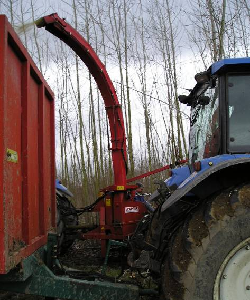
|
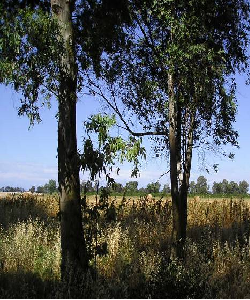
|
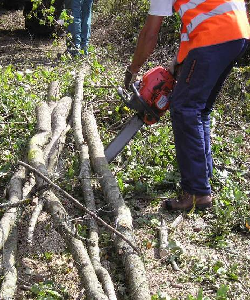
|
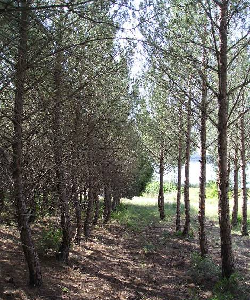
|
| Figure 01-01 15: Different ligno-cellulosic biomasses originated from trees; short rotation coppice (upper left), road windbreak (upper right), deciduous hardwood forests (lower left) and young stands of conifers (lower right) (source: Casini) | |
Many other situations (such as maintenance of public green areas in urban parks, land reclamation works along the banks of rivers, etc.) generate opportunities for collection of valuable ligno-cellulosic biomasses. However it should be carefully planned in advance as that bio-fuel might vary significantly in terms of properties, quality and availability.
Needles and leaves, for instance, have greater moisture content compared to wood, reducing the energy content of the fuel. Moreover, their higher ash content causes less efficient combustion and leads to the higher ash disposal costs. Another factor influencing the overall biomass quality in the great extent is the presence of impurities, typically caused by the handling system adopted, and mainly constituted by soil and stones (Figure 01-01 16).
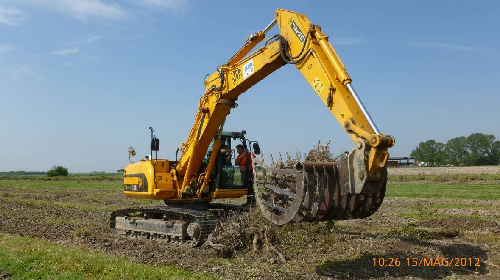
|
| Figure 01-01 16: Stump biomass can be roughly cleaned by impurities with an appropriate handling (source: Picchi) |
In many cases the low fuel quality is more than counterbalanced by the large availability of the biomass and its low furnace-gate cost. In this case it could be worth to design a dedicated combustion system capable to efficiently process the specific woody biomass available in the surrounding area. An example of such facility can be found in the district heating plant of Cloz (Trentino, Italy). This ~0.7 MW boiler is designed specifically for the combustion of crushed apple tree roots collected by the uprooting operations on the local apple orchards (Figure 01-01 17 and Figure 01-01 18). The fuel is inevitably contaminated with large amounts of mineral impurities and is considered as of a very low quality. Nevertheless the boiler, in about 6 years of service life so far, had reliability comparable to that of similar boilers fuelled with clean wood chips. The only difference when compare to standard fuels is a huge production of ashes reaching ~1 m3 per day.
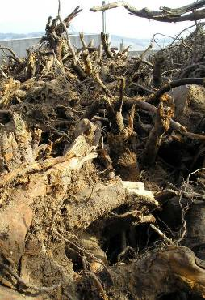
|

|
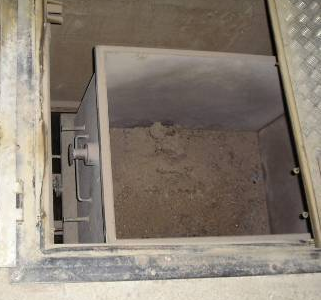
|
| Figure 01-01 17: The stumps of apple trees (left) have a high content of impurities (middle) producing large amounts of ashes in the combustion phase (right) | ||
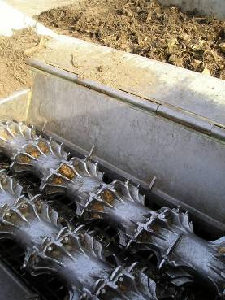
|
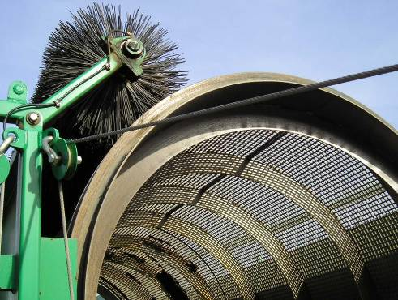
|
| Figure 01-01 18: The grinder (left) and the sieve cylinder (right) are the necessary equipment to comminute the biomass from uprooting operations of apple orchards | |
01-01-04: Introduction to solid wood fuels from industry
Apart of the forest operations, pure ligno-cellulosic residues (untreated and without impregnation) can be made available for energy use by other productive activities, such as the wood industry. Sawmills, for example, utilize an industrial processing systems which use logs as raw material to produce sawn timber (as a main product) and residues at a ~constant rate. Consequently, the available amount of residues from sawmill will be just a fraction (more or less constant) of the total quantity of processed timber.
Please consider Figure 01-01 19 for visualization of the possible biomass resources when considering the whole tree to be processed in to sawn timber. Only ~28 % of the whole tree weight is a final product and the rest (72 %) might be considered as a possible resource for bio-fuel.

|
|
| Figure 01-01 19: Share of the products and wastes when considering processing of the whole tree from forest (source FAO) | |
It is rather difficult to provide very general data on the destination of the wood residues from sawmills in the EU (or world) level. It can be however illustrated on the base of example from Trentino region (Table 01-01 4).
| Market sector | Bark | Shavings etc. | Chips | Saw dust |
| Provincial DHP | 9 622 | 6 860 | 116 810 | 3 352 |
| Extra-Provincial DHP | 1 550 | 11 953 | 95 031 | 0 |
| Mulch for gardening and forest nursery | 10 576 | 0 | 0 | 0 |
| Mulch for feedstocks | 0 | 0 | 0 | 0 |
| Small-scale biomass plants | 626 | 3 328 | 17 214 | 0 |
| Pellet and panels industry | 17 795 | 3 402 | 5 164 | 104 979 |
| Internal in saw-mills | 4 | 1 287 | 24 792 | 10 827 |
| Others / Unknown | 855 | 14 065 | 0 | 57 900 |
| Total | 41 027 | 40 894 | 259 010 | 237 506 |
| Table 01-01 4: Final destination (market sector) of the sawmill waste wood in the province of Trento (m3 year-1) (source: BIOMASFOR) | ||||
Sawmill residues are usually characterised by a specific density (depending on wood species and moisture content). From the practical point of view their overall bulk density plays a major role, being the main factor in determining the space required for storing this material (as shown on Figure 01-01 14). The wood chips produced in sawmill are accumulated in a special compartment along the processing line and evacuation system. In spite of the considerable size of the storage area the contained weight is relatively low. The bulk volume of wooden chips is approximately 200 to 300 kg m-3.
Pellet as a par excellence industrial product have a great commercial success in recent years. The remarkable increase of using pellets for energy in several countries (such as Italy, Greece, Poland) depends on a real boom not of big size boilers, but of domestic stoves, which are cheaper to buy and easier to be installed to improve/replace existing heating systems in a household size applications. In other places however (such as Sweden) the new build big size district heating plants are recently constructed basing on pellets as a main fuel. Table 01-01 5 illustrates an example for the shear of pellet production in Europe Union in 2008.
| Country |
Production (1000 tonnes/year) |
Consumption (1000 tonnes/year) |
| Austria | 626 | 509 |
| Finland | 373 | 150 |
| Germany | 1 460 | 900 |
| Italy | 650 | 850 |
| Latvia | 379 | 39 |
| Poland | 350 | 120 |
| Sweden | 1 405 | 1 850 |
| Others | 2 234 | 3 535 |
| EU Total | 7 477 | 7 953 |
| Table 01-01 5: Production and consumption of wooden pellets in Europe (source; Europe Pellet Center) | ||
The continuously increasing market demand for pellets makes an optimistic prospect for pellet producers. On the other hand it is expected increase of a competition for the raw ligno-cellulosic resources between other wood industries (sawmill, paper, panels, etc.). According to several simulations it might happen in ~2020 that the supply of the ligno-cellulosic raw materials would meet the demand (Eurowood). Refer to chapter 02-01 for more details.
01-01-05: Introduction to fuels from other wood industries
Sawmill industry is not the only one generating biomasses suitable for bio-conversion. There is several other dealing with furniture, panels, plywood, fibreboards and so on. Even if quantity of raw resources might be very high in some cases, such industries are rather hardly available as biomass providers. Most of these are highly developed and posses detailed established technological processes; all the by-products and/or waists are or recycled in to production or utilized for own energy production. It can be also stated that pulp & paper industries are rather competitors for biomasses and any kind of bio-resources (including black liquor) is processed inside of the plant or even within the same production line.
01-01-06: Introduction to fuels from wood wastes
Various types of ligno-cellulosic wastes might be also considered as important source of fuels:
• Municipal solid wastes are originated from residential, commercial, institutional, and industrial sources. Each of these generates different sorts of wood waste, with differing degrees and levels of utility as fuels. Lumber, shipping pallets, trees, branches, and other wood debris from house holders clearings might be examples of such wood wastes.
• Construction and demolition wastes are defined as solid, largely inert waste resulting from the construction, repair or demolition of buildings, roads and other structures. The term also covers debris from the clearing of land for construction.
Other sources of ligno-cellulosic wastes might include also chemically treated wood, such as railroad ties, telephone and utility poles, miner poles, constructors, pier and dock timbers. Chemical treatments and elevated costs of collection and processing of such wastes make it problematic for utilization as bio-fuels. Please refer to the chapter 02-01 for detailed waste wood classification and/or chapter 04-01 for its possible processing.
01-01-07: Planning aspects
Trees provide enormous opportunities for both natural environment and economy, especially if considering biomasses. A lot of work (labour) opportunities are related with bio-energy production.
The available sources for ligno-cellulosic biomasses include:
• forests
• short rotation coppice (SRC)
• short rotation forestry (SRF)
• young stands of conifers;
• deciduous hardwood forests
• road windbreak and urban parks-originated trees
• residues originated from agricultural activities related to woody crops (such as apple trees, olives, grapes, etc.)
• solid wood industry
• other (than sawmill) wood industries
• municipal solid wood wastes
• construction and demolition wood wastes
• and others
Industrial wood residues are often considered as more attractive than forest biomass because of more homogeneous quality (no needles or leaves and generally no bark) and more reliable supply system compared to the production of forest residues
The characteristics of available ligno-cellulosic biomass are the main parameter to be considered when selecting and planning biomass conversion technology. The most important properties affecting quality include:
• density
• bulk density
• water content
• energy content
• presence of impurities (especially soil, stones and preservatives)
|
It is extremely important to assure proper management of the biomass along the whole supply chain in order to minimize its contamination with inorganic materials. |
It is crucial to choose the combustion technology or the specific solutions in the appliance according to the biomass actually available. In this respect it should be kept in mind that as a rule of thumb small appliances will have high quality requirements (but as explained, if specifically designed for a fuel they can accept also materials commonly considered as awful biomass). For sure a small appliance will have low (or no) flexibility in accepting different types of fuels. The opposite generally holds true for large furnaces.
References
• Center for International Forestry Research. Fuelwood Revisited.
• International Energy Agency. Energy for cooking in developing countries.
• FAO (Food and Agriculture Organization)
•
Conversion of lignocellulose
•
European pellet co-operation